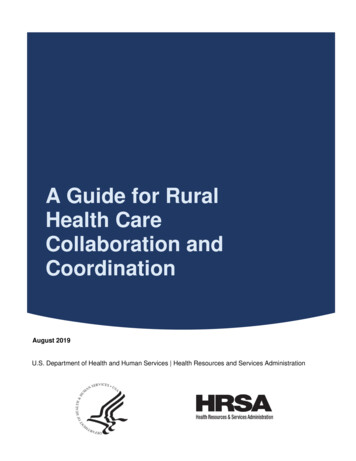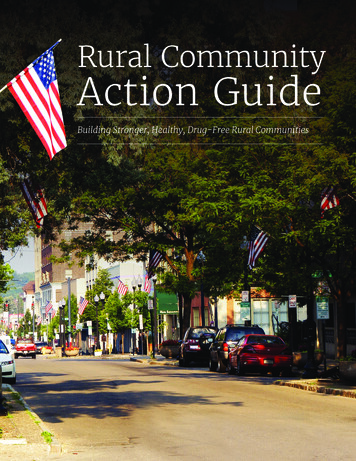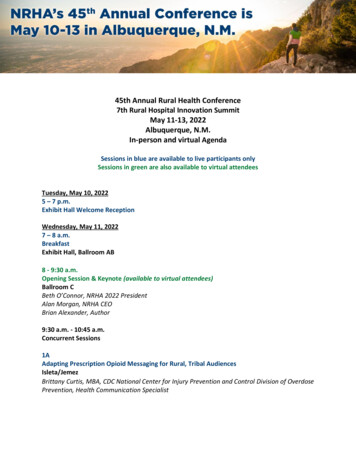
Transcription
A Guide for RuralHealth CareCollaboration andCoordinationAugust 2019U.S. Department of Health and Human Services Health Resources and Services Administration
A Guide for Rural Health Care Collaboration and CoordinationThe publication was produced for the U.S. Department of Health and Human Services, HealthResources and Services Administration, under Task Order No. HHSH25034002T.This publication lists non-federal resources in order to provide additional information to consumers.The views and content in these resources have not been formally approved by the U.S.Department of Health and Human Services (HHS) or the Health Resources and ServicesAdministration (HRSA). Neither HHS nor HRSA endorses the products or services of the listedresources.A Guide for Rural Health Care Collaboration is not copyrighted. Readers are free to duplicate anduse all or part of the information contained in this publication, however the photographs arecopyrighted and may not be used without permission.Pursuant to 42 U.S.C. § 1320b-10, this publication may not be reproduced, reprinted, orredistributed for a fee without specific written authorization from HHS.Suggested Citation: U.S. Department of Health and Human Services, Health Resources andServices Administration, A Guide for Rural Health Care Collaboration. Rockville, Maryland: U.S.Department of Health and Human Services, 2019.I
A Guide for Rural Health Care Collaboration and CoordinationTable of ContentsForeword . IVExecutive Summary . VHow to Use This Guide . 1Section 1. Why Rural Health Care Provider Collaboration and Coordination isImportant Today . 2Section 2. Rural Health Care Provider Collaboration and Coordination: Areas forConsideration . 4Section 3. Examples of Rural Collaboration and Coordination . 15Appendix I. Acronyms List . 27Appendix II. Information Resources . 28Appendix III. Case Studies . 35Appendix IV: Guide Contributors . 58II
A Guide for Rural Health Care Collaboration and CoordinationList of Exhibits, Tables, and FiguresExhibit 1.Rural Health Safety Net Providers. VIFigure 1.Rural Health Care Collaboration and Coordination: Areas for Consideration . 4Figure 2.Community Needs Assessment Requirements . 6Figure 3.Types of Organizations to Learn More About In Your Rural Community . 7Figure 4.Total Number of ACOs by Hospital Referral Region (2018) . 9Table 1.Questions to Facilitate Collective Discussions with Potential Partners . 13Figure 5.Missouri Case Study Key Features . 16Figure 6.Rural Health Network’s Incremental Development (2003-Present) . 17Figure 7.Rural Health Network’s Key Components. . 18Exhibit 2.Rural Health Network’s Key Performance Indicators and Outcomes . 20Figure 8.North Dakota Case Study Key Features . 21Appendix III. Case StudiesCase Study 1 MissouriFigure 1.Geographical Service Area of Case Study 1 . 37Figure 2.Rural Health Network’s Key Components . 38Figure 3.Rural Health Network’s Incremental Development (2003-Present) . 39Exhibit 1.Rural Health Network’s Key Performance Indicators and Outcomes . 41Exhibit 2.Impact Report: Health Care Coalition of Lafayette County. 42Case Study 2 North DakotaFigure 1.Geographical Service Area of Case Study 2 . 46Figure 2.Sample of Board Bylaw Language Supportive of Overlapping FQHC andCAH Board Members . 50Figure 3.FQHC and CAH Common Mission and Vision Statements . 51Figure 4.Multi-Provider Care Coordination Committee Membership . 54Figure 5.Financial Outcomes Associated with Collaboration and Coordination . 57III
A Guide for Rural Health Care Collaboration and CoordinationForewordThe Health Resources and Services Administration (HRSA), the primary federal agency forimproving health care to people who are geographically isolated, economically or medicallyvulnerable, is proud to present this Guide to Rural Health Care Collaboration and Coordination.Rural areas face a myriad of challenges to building healthy communities, from provider shortagesand low health care reimbursement rates to small patient volumes and older, sicker, and poorerpopulations. Safety net providers, such as health centers, rural health clinics, Critical AccessHospitals, public health departments, and others, can play a key role helping to meet the needs ofso many rural communities. However, with limited economies of scale and heavy dependence onpublic payers, providers may feel they have to compete with each other, resulting in potentialunnecessary duplication of services and additional strains on already-fragilefinances. Collaboration among rural providers can actually enhance service delivery and improvecoordination by building economies of scale and leveraging the strengths of each individualorganization.The Guide to Rural Health Care Collaboration and Coordination discusses how rural providers canwork together to identify the health needs in their communities, create partnerships to addressthose needs, and develop a “community-minded” approach to health care. It illustrates throughcase studies how providers in two communities created networks and partnerships to improve theefficiency of care, optimize resources, and improve the lives of their residents. Finally, it includeslinks throughout and resources in the Appendix for readers to access up-to-date information onrelevant policies and regulations not otherwise covered in the Guide.As one rural provider told us, “In an environment as rural as we are, it just doesn’t make sense tohave duplication. We need to capitalize on the limited resources we have.”We could not agree more. It is our hope that this Guide can be an important resource for ruralcommunities.Thomas J. EngelsActing Administrator, Health Resources and Services AdministrationIV
A Guide for Rural Health Care Collaboration and CoordinationExecutive SummarySafety net health care providers in rural communities (see Exhibit 1) face a unique combination ofchallenges, including limited economies of scale, heavy dependence on public payers, low patientvolume, and unnecessary duplication of services among providers. Given these circumstances,rural providers like Health Centers/Federally Qualified Health Centers (FQHCs), small ruralhospitals, Critical Access Hospitals (CAHs), Rural Health Clinics (RHCs), and local public healthdepartments may perceive some level of competition with each other for limited resources, staff,and patients, which can put key services at risk. This Guide discusses and illustrates through casestudies how collaboration and coordination among rural providers can address these issues andimprove care for these communities.A Guide for Rural Health Care Collaboration and Coordination was developed in cooperation withlocal, state, and national level leaders representing various rural health care organizations (seeAppendix IV). Below are key lessons learned from efforts these leaders have pursued in their ownrural communities. These lessons are discussed in more depth later in the Guide.Key Lessons Learned from Rural Health Leaders on Implementing Collaboration and CoordinationStrategies1. Leverage use of existing data sources to inform meaningful collaboration and coordination Organizations can use existing information, such as needs assessments and electronic health record (EHR) data, toidentify the needs of the patient population and the organizations that can best meet those needs. Reviewing public information sources (e.g., strategic plans, regulatory filings, needs assessments, and technicalreports) can help deepen the understanding of other organizations in the community and identify shared priorities.2. Engage potential partners The community health needs assessment process can be an opportunity to engage with potential partners. Organizations with no prior history of collaboration might start with a small-scale project to establish a workingrelationship for larger projects. Taking a “community-minded” approach can encourage engagement with other potential partner organizations,recognizing that no single organization can address all of the community’s needs.3. Develop a collective strategy Collaborations are more effective when designed collectively by all participating organizations, rather than beinginitiated and dominated by a single organization.4. Commit to transparency and honest communication Candid and honest conversations among potential partner organizations can result in clear expectations and roledelineations. When a relationship between two organizations has a strong foundation of trust, sharing board members can be aneffective way to increase transparency and enhance collaboration/coordination.5. Set realistic expectations and prepare for potential changes Not every strategy will be successful; failed strategies and partnerships can provide valuable learning experiences thatenhance the success of future partnerships. Leaders are important to establishing and maintaining collaboration and coordination; however, leaders will likelychange. Formally document partnerships through memoranda of agreement (MOA) or memoranda of understanding(MOU) so that collaboration and coordination efforts can survive the departure of the leaders who initiated them.6. Identify measures to monitor progress and performance Identifying meaningful measures helps guide improvement and performance of collaboration/coordination efforts. Use of performance measures data can help garner sustainability support from others in the community.7. Complete due diligence before committing to a strategy All organizations involved in a collaboration/coordination strategy must first ensure that the strategy complies with allof their programmatic and regulatory requirements.V
A Guide for Rural Health Care Collaboration and CoordinationExhibit 1. Rural Health Safety Net ProvidersThe National Academy of Medicine describes the rural health safety net as a complex web of publicand private professionals and institutions that provide a majority of care to the uninsured,underinsured, low-income, or Medicare and Medicaid recipients. They fill this role because of legalrequirements or out of a sense of charity and duty. Prominent safety net providers for rural areas are:Rural Health Clinics (RHC). Created by the Rural Health Clinics Act of 1977, RHCs are certified byCMS to provide primary care services in non-urbanized areas that have been designated by HRSA asa shortage area within the last four years. RHCs must have a physician as the medical director, butthey also must employ at least one nurse practitioner (NP), physician assistant (PA), or certified nursemidwife (CNM) to be onsite for half the time the clinic is open. They may be independent clinics,similar to a doctor’s office or other outpatient/ambulatory clinic, or provider-based as an integral andsubordinate unit of a hospital, nursing home, or home health agency.The Health Center Program and Federally Qualified Health Centers (FQHC). The terms “healthcenter” and “FQHC” are often used interchangeably because the two are intertwined. In 1975, theHealth Center Program was authorized under Section 330 of the Public Health Service (PHS) Act (42U.S.C. 254b). The Omnibus Budget Reconciliation Act of 1990 created the Federally Qualified HealthCenter (FQHC) provider type to allow entities in the federal Health Center Program to receive FQHCspecific Medicare and Medicaid payments for services. Eligible entities must apply to the HealthResources and Services Administration (HRSA) to receive Health Center Program grant or look-alikedesignation before applying to CMS for FQHC certification. Health centers are required to provideservices regardless of patients’ ability to pay and charge for services on a sliding fee scale. The HRSAHealth Center Program website provides additional information on health centers and Section 330requirements.Only certain organizations are eligible to enroll in Medicare and Medicaid as FQHCs: Health Center Program award recipients: Organizations receiving grants under Section 330 ofthe PHS Act. Health Center Program grant funding is awarded competitively, based on fundingavailability. Health Center Program look-alikes (LAL): Organizations that meet the requirements of the HealthCenter Program, but that do not receive grant funding under Section 330. Entities may apply atany time for look-alike designation. Tribal entities that operate an outpatient health program or facility of a tribe or tribal organizationunder the Indian Self-Determination Act or as an urban Indian organization receiving funds underTitle V of the Indian Health Care Improvement Act as of October 1991. Tribal entities applydirectly to CMS for certification.For the purposes of this Guide, the term health center(s) refers to either HRSA Health Center Programaward recipients or Health Center Program look-alikes.Rural Hospitals. Recognizing the vital role that hospitals play in rural areas, Congress and CMSinstituted several formal rural hospital safety net authorities, including Critical Access Hospitals(CAHs); Sole Community Hospitals (SCH) and Medicare Dependent Hospitals (MDH); Medicare andMedicaid Disproportionate Share Hospital (DSH) payment adjustments; and the low-volume paymentadjustment. The Emergency Medical Treatment and Labor Act (EMTALA) of 1986 ensures that thepublic can receive emergency services regardless of their ability to pay, and Section 1867 of theSocial Security Act requires that Medicare-participating hospitals with emergency services provide amedical screening examination when requested or treatment for an emergency medical conditionregardless of an individual's ability to pay.VI
A Guide for Rural Health Care Collaboration and CoordinationHow to Use This GuideThis Guide provides the following information for rural health care organization leaders toconsider as they explore collaboration and coordination * strategies: An overview of relevant changes in the current health care environment, which expandscollaboration and coordination opportunities Factors to consider for effective and meaningful health care collaboration and coordination Examples of rural health care collaboration and coordinationThe Guide is divided into three sections:Section 1Why Is Rural Health Care Provider Collaboration and Coordination Important Today? Thissection provides an overview of potential benefits of collaboration and coordination among ruralhealth care organizations.Section 2Rural Health Care Provider Collaboration and Coordination: Key Elements to Consider. Thissection outlines factors to consider for new and existing collaboration and coordination efforts. Thissection draws from the experience of rural health care leaders who have implemented collaborationand coordination strategies.Section 3Examples of Current Rural Collaboration and Coordination. This section presents twocollaboration and coordination case studies that illustrate the key elements presented in the Guide.Throughout Sections 1 through 3, live links will help you navigate the Guide and accessinformation resources outside of the Guide. The Guide also includes Appendices that containadditional tools and resources:Appendix IAcronyms. List of acronyms used in the Guide.Appendix IIUseful Tools & Resources. Additional tools and resources relevant to Section 2 are provided.Appendix IIICollaboration and Coordination Examples. Expanded versions of the case studies discussed inSection 3 are included, so rural health stakeholders can print and share these examples to helpkick off discussions about collaboration and coordination.Appendix IVGuide Contributors. List of experts who provided guidance and lessons learned for this Guide.*NOTE: For the purposes of this Guide, collaboration is defined as activities in which providers work together through variousvehicles (e.g., contracts, formal memoranda of understanding, and data use agreements etc.) to maximize resources andefficiencies, with a common goal of ensuring access and provision of services to rural populations. Coordination is the deliberateorganization of and communication about patient care activities between two or more participants involved in a patient’s care tofacilitate the appropriate delivery of quality health care and social services.1
A Guide for Rural Health Care Collaboration and CoordinationSection 1. Why Rural Health Care Provider Collaboration andCoordination is Important TodaySafety net health care providers in rural communities face a unique combination of challenges,including limited economies of scale, heavy dependence on public payers, low patient volume,and sometimes unnecessary duplication of services among providers. Given thesecircumstances, lack of collaboration can put key services at risk given the often-fragile economicstatus of rural providers like Health Centers, small rural hospitals, Critical Access Hospitals(CAHs), Rural Health Clinics (RHCs), and local public health departments. The Guide includescase studies on how collaboration and coordination among rural providers can address theseissues and improve care for these communities.The U.S. health care delivery system continues to undergo rapid transformation. The shift froma volume-based, fee-for-service payment system to one based on value has promptedexploration of new service delivery and reimbursement models that focus attention on healthoutcomes and population health. At the same time, there is growing interest in patient-centeredapproaches to care and in encouraging patients to take a more active role in their health andtheir care. These transformations reward organizations that can demonstrate improvedoutcomes by coordinating care and treating patients holistically, taking into account not onlytheir immediate medical needs but also their physical environment and social and economicsituations (often referred to collectively as “social determinants of health”).Collaboration and coordination can offer solutions to problems that commonly affect rural areas: Financial Viability. Public payers account for a large share of the overall payer mix in ruralareas. 1 Their relatively low reimbursement rates, combined with a limited private insurancebase, often put a financial strain on rural providers. Pursuing collaboration andcoordination with other organizations in their service areas can strengthen thefinancial position of rural providers by allowing them to participate in value-basedpayment models and creating opportunities to share resources. Health Workforce. Health workforce shortages in rural areas can limit access, hittingprimary care and mental health services hardest. Over half of primary care medical healthprofessional shortage areas (HPSAs) are located in rural areas. 2 Approximately 65 percentof rural counties do not have access to a psychiatrist, and 47 percent do not have accessto a psychologist. 3 Collaboration and coordination among providers can lead to moreeffective and efficient service delivery implementation, which can assist inrecruitment and retention of health care professionals. Health Care Access. Some rural hospitals are at risk for closure or for closing service lines(e.g. obstetrics units) due to financial viability challenges, 4,5 jeopardizing access toemergency and other important services. Collaboration and coordination can helpmaintain and enhance health care access through reducing duplication of services.2
A Guide for Rural Health Care Collaboration and Coordination Social Determinants of Health. A variety of non-medical factors influence how patientsinteract with the health care system and how well they are able to manage their health.These include education level, income, employment, housing quality and stability, thestrength or weakness of social relationships, access to transportation, and availability ofnutritious and affordable food. Problems in any of these areas can contribute to increasedchronic conditions, substance abuse disorders, and shorter life expectancy in rural areas. 6Working with other community-based organizations allows health care providers toaddress the social determinants of health.For the purposes of this Guide, collaboration is defined as activities in which providers worktogether through various vehicles (e.g., contracts, formal memoranda of understanding, datause agreements, etc.) to maximize resources and efficiencies, with a common goal of ensuringaccess and providing services to rural populations. Coordination is the deliberate organization ofand communication about patient care activities between two or more participants involved in apatient’s care to facilitate the appropriate delivery of quality health care and social services.3
A Guide for Rural Health Care Collaboration and CoordinationSection 2. Rural Health Care Provider Collaboration andCoordination: Areas for ConsiderationNo single organization can address all needs of its community. However, by collaborating andcoordinating with other organizations, rural health care providers can extend their reach andcapabilities, which can lead to healthier communities and more vibrant, relevant, and financiallystable organizations. Based on a review of current rural health care efforts across the countryand interviews with rural health care stakeholders (see Appendix IV), this section presents“elements” of rural collaboration and coordination that leaders of rural health organizations canuse to inform new or enhance existing collaboration and coordination efforts. Figure 1 illustratesthe elements and outlines their key characteristics. While each element builds on the others andideally organizations would address each element in sequence, organizations can—andshould—focus on element areas based on their own needs and situations in their communities.Figure 1. Rural Health Care Collaboration and Coordination: Areas for Consideration4
A Guide for Rural Health Care Collaboration and CoordinationElement 1 Analyze the EnvironmentElement 1 Key Takeaways Leverage existing information sources to identify community needs. Begin to develop an in-depth understanding of existing and future potential partners to addressthose needs. Be aware of national, state and local trends that may affect your collaboration and coordinationefforts.See Appendix II, Element 1 for additional information resources.The first step is to identify potential areas of need in the community that could be addressedthrough collaboration/coordination with new or existing partners.Leverage Existing Information SourcesStart by reviewing existing information sources alreadyaccessible to your organization to identify communityneeds.For example, electronic health record (EHR) data,community surveillance systems (e.g., condition-specificpatient registries) can contain valuable insight on healthcare utilization, gaps in services, and areas in need ofimprovement among your patient population. Comparingthe most recent community health needs assessmentsfor all organizations in your community can reveal whichneeds have been identified by multiple partners andshould be prioritized in any collaboration.Public health departments, health centers *, † and nonprofit hospitals are all required by federal law oraccreditation requirements to produce community needsassessments regularly (see Figure 2).Potential PartnerOrganization InventoryConsider developing a potential partnerorganization inventory (e.g., a table orspreadsheet) that is grouped accordingto your organization’s patient populationhealth needs. Next to each patientpopulation need, make a list of potentialprovider organizations that you mightconsider working with to help addresseach need. A document outlining thisinformation may be useful to share withyour organization’s board to informdiscussions or plans for futurecollaboration and coordination withothers in your community. Thisdocument could also be useful whenpreparing for discussions with potentialpartners. See Appendix II for a sampletemplate from the North Dakota StateOffice of Rural Health that was slightlymodified for this Guide.*“As part of Health Center Program requirements established under Section 330 of the Public Health Service (PHS)Act and through regulations, health centers are required to regularly complete a community needs assessment.”† For the purpose of this Guide the term health center(s) refers to either HRSA Health Center Program awardrecipients or Health Center Program look-alikes.5
A Guide for Rural Health Care Collaboration and CoordinationPublic Health Departments.Figure 2. Community Needs Assessment RequirementsPublic health plays a vital roleSafety NetPlanningPlanning Requirementin addressing populationOrganizationFrequencyhealth in rural communities,Community Health Assessment;HealthCommunity Health ImprovementAt least 1xparticularly preventionPlan (conducted to obtain/maintainevery 3-5 yrs.Departments 7activities. State healthpublic health accreditation)departments must produce aNon-profit RuralState Health Assessment,Hospitals;Community Health NeedsAt least 1xAssessment; ImplementationCritical AccessState Health Improvementevery 3 yrs.8StrategyHospital ; PPSPlan, and Health DepartmentRural HospitalsStrategic Plan to earnAt least 1xHealth Centers 9Needs Assessmentevery 3 yrs.accreditation from the PublicHealth Accreditation Board(PHAB). On the local level, PHAB requires local health departments to complete a CommunityHealth Assessment (CHA) and Community Health Improvement Plan (CHIP) every three tofive years. 10 Reviewing these documents can reveal potential new partners to work with, andexisting collaboration and coordination occurring in your community to potentially leverage.To learn more about these requirements, access the PHAB website.Nonprofit Rural Hospitals. In 2015, the Internal Revenue Service (IRS) began requiringnonprofit hospitals to complete a Community Health Needs Assessment (CHNA) and anImplementation Strategy every three years to identify and prioritize health or social needs toinvest their community benefit dollars. CHNAs must reflect input from the community, includingthose with special knowledge of or expertise in public health. The IRS requires hospitals toconsider social, behavioral, and environmental factors that influence health in the community.More information about CHNAs and Implementation Strategy requirements are available on theIRS website.Health Centers. As part of Health Center Program Requirements established under Section330 of the Public Health Service (PHS) Act and through regulations, health centers are requiredto regularly complete a community needs assessment.Please see Element 2 and Element 3 sections for further information on how to leverage acommunity health needs assessment to meaningfully engage potential partners incollaboration/coordination.After reviewing existing data sources and identifying the most urgent needs among your patientpopulation, analyze what assets, capabilities, and resources are available to address theseneeds. Next, consider the assets, capabilities, and resources of other state, regional or localorganizations that might augment or improve your organization’s effectiveness in addressingthese needs. Refer to Figure 3 for a list of provider types and programs that may be potentialpartners. Also, see Appendix II for useful tools and resources to inform your efforts to identifypotential partners.6
A Guide for Rural Health Care Collaboration and CoordinationUnderstand Your PartnersAfter you identify your patientpopulation’s needs, the next step isto create a list of organizations inyour community, either current orpotential partners that may be ableto help you address those needs.Then, identify the organizationalrelationships that you may need tocultivate in order to developmeaningful collaboration/coordination to address a sharedneed.An in-depth understanding of otherorganizations in your communitycan help identify similarities anddifferences that may affect yourworking relationship, organizationalissues that may need to beresolved, and areas where youmay need to address otherorganizations’ concerns about yourown organization.Fi
The Guide to Rural Health Care Collaboration and Coordination discusses how rural providers can work together to identify the health needs in their communities, create partnerships to address those needs, and develop a "community-minded" approach to health care.











